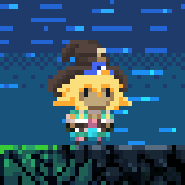Ogham (O-am)
Lost language of the Irish and Picts
According to most scholars, Ogham is an ancient language, used by the Celts and Picts, from the fourth to tenth centuries CE. This ideology is contested by a few scholars who believe the language is actually far older and is from the fourth century BCE. The ending dates are usually agreed upon by all involved.
Ogham is usually read bottom to top, left to right; that is, if it is not inscribed on a stone. When inscribed on stone it reads from the bottom left around the edge to the bottom right.
Each letter has an association with a different tree (see alphabet for more details).
bi dilis duit fein
be true to yourself
ta me i ngra leat
I love you
gra mo chroi
love of my heart
is tu mo rogha
you are my chosen one
inar gcroi go deo
forever in our hearts
ceart dom ceart duit
live and let live
neart agus onoir
strength and honor
a chuisle mo chroi
pulse of my heart
nil aon tintean mar do thintean fein
home is where the heart is
ni thugann aon rud ach seal
nothing lasts forever
Common Phrases:
be true to yourself
I love you
love of my heart
you are my chosen one
forever in our hearts
live and let live
strength and honor
pulse of my heart
home is where the heart is
nothing lasts forever
History:
Ogham was used by the Celtic tribes, from before the time of the Roman invasion until the Norman invasion. Though there are very few people who know how to read it, Ogham has had a resurgence in popularity with the return of magic. In 2174 there were a total of seventy-five scholars who could read Ogham. This was due to an extensive study of anthropology and ancient languages. With the return of magic, Ogham became a favoured script to pass messages in. This was on the off chance that someone from the religious sect happened to get a hold of it.Writing System
aicme b (first aicme)
B
L
F
S
N
aicme h (second aicme)
H
D
T
C
Q
aicme m (third aicme)
M
G
P
Z
R
aicme a (fourth aicme)
A
O
U
E
I
aicme h (second aicme)
aicme m (third aicme)
aicme a (fourth aicme)
aicme b (first aicme)
B Beith (b)
L Luis (l)
F Fearn (v)
S Saille (s)
N Nion (n)
aicme h (second aicme)
H Huath (y)
D Duir (d)
T Tinne (t)
C Coll (k)
Q Quert (kw)
aicme m (third aicme)
M Muin (m)
G Gort (g)
P Ngétal (gw)
Z Straif (sw/ts)
R Ruis (r)
aicme a (fourth aicme)
A Ailm (a)
O Onn (o)
U Úr (u)
E Eadhah (e)
I Iodhadh (i)
B Beith (b)
L Luis (l)
F Fearn (v)
S Saille (s)
N Nion (n)
aicme h (second aicme)
H Huath (y)
D Duir (d)
T Tinne (t)
C Coll (k)
Q Quert (kw)
aicme m (third aicme)
M Muin (m)
G Gort (g)
P Ngétal (gw)
Z Straif (sw/ts)
R Ruis (r)
aicme a (fourth aicme)
A Ailm (a)
O Onn (o)
U Úr (u)
E Eadhah (e)
I Iodhadh (i)
aicme b (first aicme)
Birch
Rowan
Alder
Willow
Ash
aicme h (second aicme)
Hawthorn
Oak
Holly
Hazel
Apple
aicme m (third aicme)
Vine
Ivy
Reed
Blackthorn
Elder
aicme a (fourth aicme)
White fir
Gorse
Heather
Poplar
Yew
Birch
Rowan
Alder
Willow
Ash
aicme h (second aicme)
Hawthorn
Oak
Holly
Hazel
Apple
aicme m (third aicme)
Vine
Ivy
Reed
Blackthorn
Elder
aicme a (fourth aicme)
White fir
Gorse
Heather
Poplar
Yew
Vocabulary
Dictionary of sorts:
a do
two
aibhneacha
rivers
aintin
aunt
athair
father
capaill
horses
ceathrar
four
crainn
trees
crann
tree
dearthair
brother
deirfiur
sister
foraoise
forest
forsa
force
forsai
forces
iolair
eagles
lamh
hand
lamha
hands
loch
lake
lochanna
lakes
seabhaic
hawks
sicini
chickens
sruthan
stream
sruthanna
streams
triur
three
ull
apple
0
0
1
1
2
2
3
3
4
4
5
5
6
6
7
7
8
8
9
9
abhainn
river
ag deanamh
doing
ait
where
ata
are
b'fheidir
maybe
ba
cows
bhaile
home
bheith
be
bo
cow
cad
what
cait
KAY , cats
capall
horse
cat
cat
cathain
when
ce
whom
cead
hundred
ceann
one
cen fath
why
chol
dove
cuig
five
dheanamh
do
e
it
eds
who
faoi
about
feadfaidh
may
feidir
can
foscadh
shelter
gra
love
iolar
eagle
laoch
warrior
madra
ma-DRA , dog
madrai
ma-DRAI , dogs
Mathair
mother
mhor
more , grand
mile
thousand
mo
my
nil
no
sea
yes
seabhac
hawk
seanathair
shaw-NA-air , grandfather
seanmhathair
shawn-MA-air , grandmother
sicin
si- CHEN , chicken
soal
life
teallach
hearth
tu
you
uncail
uncle






Interesting, did you use or do you want Tom Scott's Video on this Language?